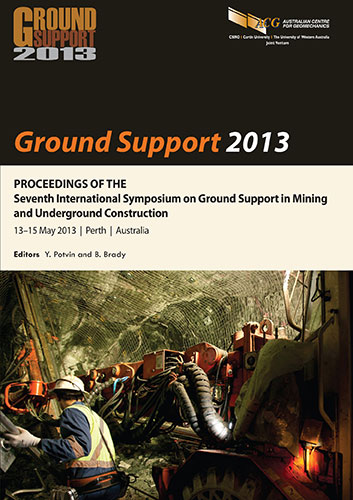When friction is no longer enough

|
Authors: Graaf, JH; Van Der Merwe, S |
DOI https://doi.org/10.36487/ACG_rep/1304_10_Graaf
Cite As:
Graaf, JH & Van Der Merwe, S 2013, 'When friction is no longer enough', in Y Potvin & B Brady (eds), Ground Support 2013: Proceedings of the Seventh International Symposium on Ground Support in Mining and Underground Construction, Australian Centre for Geomechanics, Perth, pp. 171-184, https://doi.org/10.36487/ACG_rep/1304_10_Graaf
Abstract:
Managing the transition from low stress to high stress underground environments is becoming an important issue for underground mining in Western Australia, particularly as ore bodies are being proven up at deeper levels. Cosmos Nickel Operation (CNO) is a deep nickel sulphide orebody located near Leinster, Western Australia. The friction bolt (or split set) is the rockbolt of choice for many underground operations in Western Australia. CNO used the split set with mesh or shotcrete as its only form of ground support for many years. However, with development occurring at greater depth, the ground started to behave in a different manner to before and the split set could no longer sustain the deformation associated with this transition. The serpentine altered, ultramafic host rocks began showing classic signs of squeezing rock conditions, with delamination in the walls and drive closure a common problem. The ultramafic also started to unravel and self-mine immediately after development. The footwall felsic volcanics lie at the other end of the spectrum, where the high strength and brittle nature of these rock types showed a propensity to generate strain bursting and seismic activity. This paper discusses the trial and implementation of several new types of ground support at CNO to manage the deformation associated with a higher stress environment and challenging ground conditions. The ground support systems addressed in this paper include de-bonded cable bolts, D-bolts, Omega and resin encapsulated cable bolts. As part of the trial and implementation process, we recognised the need to have a systematic approach to ground support selection and trial. This paper provides a basic methodology and framework for site based engineers to undertake ground support trials in a safe and efficient manner and also to aid with compliance to the change management process.
© Copyright 2024, Australian Centre for Geomechanics (ACG), The University of Western Australia. All rights reserved.
View copyright/legal information
Please direct any queries or error reports to repository-acg@uwa.edu.au
View copyright/legal information
Please direct any queries or error reports to repository-acg@uwa.edu.au